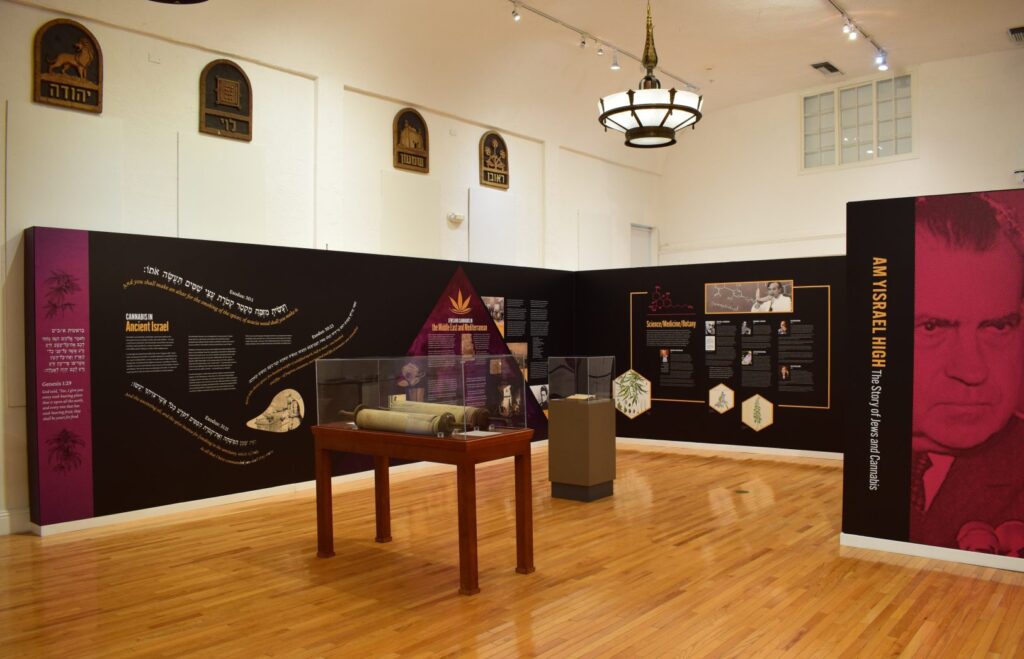You wouldn’t think it, but the venerable ancestors weren’t averse to sampling the delights of marijuana. Indeed, as “Kosher Kush,” a new exhibit at the Jewish Museum of Florida-FIU concludes, some seeds and herbs mentioned in the Bible, Talmud and other religious texts were likely cannabis.
From then to now, the exhibit looks at how cannabis was and is used by Jewish communities, including by Hebrew priests, culminating in the roles some scientists and activists — who just happened to be Jewish — have played in the larger story of how cannabis went from sacred ritual to secular intoxicant.
“We really pushed for this exhibition as a conversation-starter,” says curator Jacqueline Goldstein, adding that the show had been in the works for about a year.
“Kosher Kush” is based on and interpreted for South Florida audiences from the 2022-2023 exhibit, “Am Yisrael High: The Story of Jews and Cannabis,” at the YIVO Institute for Jewish Research in New York City.
Susan Gladstone Pasternack, the museum’s executive director, saw the show there and, according to Goldstein, “thought it would be great for us. We try to create an exhibit that creates discourse.”
And this one is likely to do so. What might be surprising to visitors is a view of biblical Hebrews that is a bit more intriguing than your general Torah story
Of special interest is the idea that the Kaneh bosem, or the “fragrant stalk” used to make anointing oils referenced in the Book of Exodus, was cannabis, according to the show’s on-the-wall entry. It is also referenced as a rope-building fiber plant (think hemp, pot’s cousin, still used today). It was also likely, the text continues, part of the incense mixture that was an integral part of Jewish religious ceremonies.
And it seems the plant was already known and used in the ancient world. According to the text, officiants at the temples of Assyria used the herb as incense as well as an intoxicant, “because its aroma was pleasing to the Gods.”
The exact composition of the incense used in the Jewish Temple of biblical narrative remains murky, but there are interesting clues, according to the exhibit. Maimonides, the famous Spanish Jewish rabbi and philosopher of the Middle Ages, said Kaneh bosem, imported from India, was used for medical purposes. Bolstering the argument for pot’s ritual role is that charred cannabis residue was discovered on a third-century BC Jewish altar, suggesting that the herb was a regular part of religious ceremonies.
Interestingly, as we move through the centuries of pot’s presence in Jewish lives, what stands out is the recurrent theme of borrowing and incorporating norms of the societies they lived among — a motif that appears in Jewish art, literature and culture through the ages, as the stateless people settled in lands from Spain to the Netherlands.
Highlights of this part of the exhibition include scraps of writing referencing cannabis found in the Cairo Geniza, a discovery of fragments that lay remote and forgotten in the storeroom of the Ben Ezra Synagogue in Egypt’s Old Cairo. Finally rescued in the late 1800s, the works span from the ninth to the 19th centuries. The fragments touch on many topics, from the sacred to the mundane, including a number of reefer references, including a humorous song that praises the advantages of wine over cannabis.
The greater part of research for the show was done by Edward Portnoy, academic advisor for exhibitions at YIVO, whose interest was piqued after he saw a photo of a glass bong in the shape of a menorah. He thought it would be a great addition to the institute and contacted its maker, the Grav company, which agreed to donate one..
The question was asked if Portnoy could create an exhibit showcasing Jews and marijuana. “I sat down and thought, ‘I could do that,’ ” he says.
It turns out that academic articles written about archeological digs of ancient synagogues were a rich source of information. “Every aspect of a synagogue dig is delved into by scholars,” says Portnoy.
Meanwhile, a friend and colleague, Marina Rustow, professor of Near Eastern studies and history at Princeton University, just happens to be deeply involved in the Princeton Geniza Project that since 1986 has been translating and digitizing the 400,000 or so fragments rescued from the Ben Ezra Synagogue. That trove was key to Portnoy’s research.
“You can do a keyword search,” he says, noting that the song extolling the virtues of wine over cannabis was from around 1300 AD. “For me, what was so fascinating is that there is an incredibly lengthy history of Jewishness and cannabis as an intoxicant in places like the Middle East. It became part of their lives and ritual.”
The exhibit features contemporary cannabis-related, Jewish-themed items, such as the aforementioned glass menorah-bong, and also details the contributions of scientists involved in 20th- and 21st-century research about the plant’s biochemical properties and possible medicinal uses, including in psychiatry.
The museum plans to organize panel discussions geared toward FIU students studying law and medicine.
The exhibit, says Goldstein, “is a terrific conversation-starter,” encouraging visitors to discuss what they may not otherwise talk about.”
IF YOU GO
WHAT: “Kosher Kush” exhibit
WHEN: Through April 20, 2025
WHERE: Jewish Museum of Florida-FIU, 301 Washington Ave., Miami Beach
COST: $12 for adults, $10 for seniors and students, free for children age 6 and younger as well as for members, FIU faculty, staff and students; free admission on Saturdays
INFORMATION: 305-672-5044
H/T: www.sun-sentinel.com




 Breaking Through: Cannabis Science Hits a Turning Point
Breaking Through: Cannabis Science Hits a Turning Point Middletown Buzz: Cannabis Dispensary Proposal Pulls Out of Historic Downtown Project
Middletown Buzz: Cannabis Dispensary Proposal Pulls Out of Historic Downtown Project Norwalk Police Raid Smoke Shop, Seize Marijuana & Nitrous Oxide
Norwalk Police Raid Smoke Shop, Seize Marijuana & Nitrous Oxide Connecticut’s Cannabis Equity Council Relaunches $36M “Reimagine & Revitalize” Grant Program
Connecticut’s Cannabis Equity Council Relaunches $36M “Reimagine & Revitalize” Grant Program